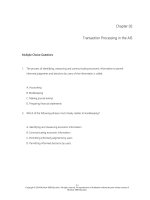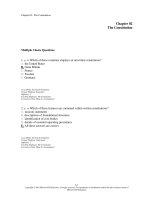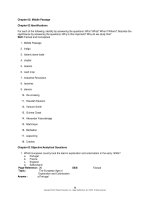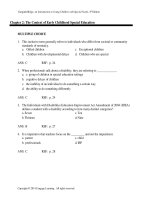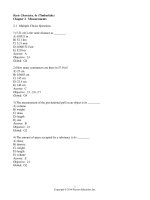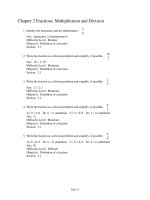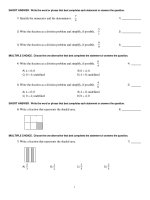College physics 4th edition giambattista test bank
Bạn đang xem bản rút gọn của tài liệu. Xem và tải ngay bản đầy đủ của tài liệu tại đây (285.48 KB, 33 trang )
Chapter 02 - Force
Chapter 02
Force
Multiple Choice Questions
1. When a person stands on a scale, which of the following is not a force exerted on the
scale?
A. a contact force due to the floor
B. a contact force due to the person's feet
C. the weight of the person
D. the weight of the scale
Section: 02.01 Force
2. A person weighs 146 pounds. The person's weight is (1 lb = 4.45 N)
A. 445 N.
B. 500 N.
C. 584 N.
D. 650 N.
Section: 02.01 Force
3. The force that holds charged atoms together is
A. gravitational force.
B. electromagnetic force.
C. weak interaction.
D. strong nuclear forces.
Section: 02.01 Force
2-1
Chapter 02 - Force
4. Three objects experience interactions. Object A has mass, object B has electrical charge,
and object C has both mass and electrical charge. Which of the following statements are true?
A. object A and object B experience an electrical interaction
B. object A and object C experience a gravitational interaction
C. object C experiences an electrical interaction with itself
D. object A and object C experience an electrical interaction
E. object A and object B experience a gravitational interaction
Section: 02.01 Force
5. Three objects experience interactions. Object A has mass, object B has electrical charge,
and object C has both mass and electrical charge. Object A and object B have a rope
connected between them. Which of the following statements are true?
A. the electrical force on A due to B has the same magnitude as the gravitational force on B
due to A
B. the gravitational force on C due to A has the same magnitude as the gravitational force on
A due to C
C. the rope force on A due to B has the same magnitude as the electrical force on B due to A
D. the rope force on B due to A has the same magnitude as the gravitational force on A due to
C
Section: 02.01 Force
6. The force that holds the nucleus together is
A. gravitational force.
B. electromagnetic force.
C. weak interaction.
D. strong nuclear force.
Section: 02.01 Force
2-2
Chapter 02 - Force
7. The force that causes an object to fall to earth is
A. gravitational force.
B. electromagnetic force.
C. weak interaction.
D. strong nuclear force.
Section: 02.01 Force
8. Which of the following is a vector quantity?
A. volume
B. force
C. speed
D. time
E. length
Section: 02.01 Force
9. A person weighs 155 pounds. What is the person's weight in Newtons?
A. 155 N
B. 689 N
C. 39.3 N
D. 392 N
Section: 02.01 Force
10. A 20 kg sack of potatoes at the corner store weighs
A. 190 pounds.
B. 150pounds.
C. 44 pounds.
D. 9.9 pounds.
Section: 02.01 Force
2-3
Chapter 02 - Force
11. If an object of mass 20 kg on earth is sent to the moon it will have a mass of
A. 10 kg.
B. 20 kg.
C. 0.0 kg.
D. 4.0 kg.
Section: 02.01 Force
12. A rock of weight 17.5 N is immersed in a beaker of water while suspended from a spring
scale with a reading of 9.00 N. The weight of the beaker and water together is 23.5 N. What is
the net force of the beaker on the table?
A. 17.5 N
B. 23.5 N
C. 2.0 N
D. 41.0 N
Section: 02.02 Net Force
13. A car is driving on a level highway. It is acted upon by the following forces: a downward
gravitational force of 12 kN, an upward contact force due to the road of 12 kN, another
contact force due to the road of 7 kN directed West, and a drag force due to air resistance of 5
kN directed East. What is the net force acting on the car?
A. 7 kN East
B. 24 kN up
C. 2 kN West
D. 5 kN East
E. 2 kN East
Section: 02.02 Net Force
2-4
Chapter 02 - Force
14. A man who weighs 600 N is sitting in a chair with his feet on the floor and arms resting
on the armrests. The chair weighs 100 N. Each armrest exerts and upward force of 25.0 N on
his arms, and the seat exerts an upward force of 500 N. What force does the floor exert on his
feet?
A. 75 N upward
B. 500 N upward
C. 525 N upward
D. 50 N upward
E. 0 N
Section: 02.02 Net Force
15. An airplane is traveling in level flight at a constant velocity. L is the lift, W is the weight,
T is the thrust, and D is the drag. Which of the diagrams is the correct free body force diagram
for the airplane?
A.
B.
C.
D.
E.
Figure 1
Figure 2
Figure 3
Figure 4
Figure 5
Section: 02.02 Net Force
2-5
Chapter 02 - Force
16. An airplane is flying in horizontal flight at a constant velocity. The weight of the airplane
is 40,000 N. The wings produce a lift force that is perpendicular to the wings and a drag force
that is parallel to the wing. The engine produces a forward thrust force of 2,000 N. Which of
the following statements is true?
A. the net force on the airplane is zero
B. the net force on the airplane is forward
C. the net force on the airplane is upward
D. the net force on the airplane is downward
E. the net force on the airplane is backward
Section: 02.02 Net Force
17. An airplane is flying in horizontal flight at a constant velocity. The weight of the airplane
is 40,000 N. The wings produce a lift force that is perpendicular to the wings and a drag force
that is parallel to the wing. The engine produces a forward thrust force of 2,000 N. Which of
the following statements is true?
A. the lift force on the airplane is zero
B. the drag force on the airplane is zero
C. the lift force on the airplane is 42,000 N upward
D. the drag force on the airplane is 38,000 N downward
E. the drag force on the airplane is 2,000 N backward
Section: 02.02 Net Force
18. The net force on a moving object suddenly becomes zero. The object then
A. stops abruptly.
B. stops during a short time interval.
C. changes direction.
D. continues at constant velocity.
E. slows down gradually.
Section: 02.02 Net Force
2-6
Chapter 02 - Force
19. A freight train consists of an engine and several identical cars on a level track. Which of
the following statements is true?
A. if the train is moving at constant speed, the engine must be pulling with a force greater
than the train's weight
B. if the train is moving at constant speed, the engine's pull on the first car must exceed that
car's backward pull on the engine
C. if the train is coasting, its inertia makes it slow down and eventually stop
D. if the train is moving at constant speed the engine's pull must be equal to the friction
Section: 02.02 Net Force
20. In the figure an airport luggage carrying train with a tractor T is pulling three luggage
carts, M1, M2, and M3, with constant velocity of 4.5 m/s. If T = 300.0 kg, M1 = 200.0 kg, M2 =
100.0 kg, and M3 = 100.0 kg, and the coefficient of kinetic friction for each is 0.4000, what is
the force in the connection between the tractor T and cart M1?
A. 2941 N
B. 2744 N
C. 1568 N
D. 1862 N
E. 2439 N
Section: 02.02 Net Force
21. Causing an object to start moving on a frictional surface requires
A. less force than is needed to keep it moving on the surface.
B. the same force as is needed to keep it moving on the surface.
C. more force than is needed to keep it moving on the surface.
D. a force equal to the weight of the object.
E. a force opposite to the normal force.
Section: 02.02 Net Force
2-7
Chapter 02 - Force
22. Five children are pushing on a snowball; each is pushing with a force of 10.0 N. Each is
pushing at an angle of 45 relative to his neighbor. What is the net push on the ball?
A. 0 N
B. 24.1 N
C. 27.1 N
D. 17 N
E. 50 N
Section: 02.02 Net Force
23. In the figure, an airport luggage carrying train with a tractor T is pulling three luggage
carts, M1, M2, and M3.with constant velocity of 4.5 m/s. If T = 300 kg, M1 = 200 kg, M2 = 100
kg, and M3 = 100 kg (there is no friction), then the force in the connection between the tractor
T and cart M1 is
A. 980 N.
B. 560 N.
C. 280 N.
D. 140 N.
E. 0.00 N.
Section: 02.02 Net Force
2-8
Chapter 02 - Force
24. The diagram below represents an ideal pulley system (no mass or friction). What is the
force required to lift the 45 kg mass?
A. 442 N
B. 393 N
C. 221 N
D. 147 N
Section: 02.02 Net Force
25. A force of 15 N toward the WEST is applied to a 4.0 kg box. Another force of 42 N
toward the EAST is also applied to the 4.0 kg box. The net force on the 4.0 kg box is
A. 57 N toward the WEST.
B. 27 N toward the EAST.
C. 36 N toward the WEST.
D. 36 N toward the EAST.
E. 17 N toward the WEST.
Section: 02.02 Net Force
26. If you add two vectors with magnitudes of 200 and 40, which of the following is the only
possible resultant?
A. 100
B. 260
C. 0
D. 200
E. 40
Section: 02.03 Vector Addition
2-9
Chapter 02 - Force
27. Diane (weight 255 N) is practicing on a tightrope that is 6.00 meters long and sags by
0.120 meters. When she is in the middle of the rope, what is the force on each eyebolt holding
the tightrope?
A. 1.62 103 N
B. 3.19 103 N
C. 6.38 103 N
D. 4.99 103 N
Section: 02.03 Vector Addition
28. Given that a vector extends from the origin to (-5.0 cm, 8.0 cm), find the magnitude of the
vector.
A. 9.8 cm
B. 3.4 cm
C. 9.4 cm
D. -5.6 cm
Section: 02.03 Vector Addition
29. Given that a vector extends from the origin to (-5.0 cm, 8.0 cm), find the direction of the
vector from the positive x-axis.
A. 32
B. 58
C. 148
D. 122
Section: 02.03 Vector Addition
2-10
Chapter 02 - Force
30. Given that a force vector extends from the origin to (120 N, -60.0 N), find the magnitude
of the vector.
A. 140 N
B. 134 N
C. 180 N
D. 60.0 N
Section: 02.03 Vector Addition
31. Given that a force vector extends from the origin to (120 N, -60.0 N), find the direction of
the vector referenced to the positive x-axis.
A. 116
B. 26.6
C. -26.6
D. 122
Section: 02.03 Vector Addition
32. Vector A has a magnitude of 3.0 units and makes an angle of -90.0 with the positive xaxis. Vector B has a magnitude of 4.0 units and makes and angle of -120 with the positive xaxis. What is the magnitude of the vector sum of A + B?
A. 1.0 units
B. 6.1 units
C. 4.0 units
D. -6.8 units
Section: 02.03 Vector Addition
2-11
Chapter 02 - Force
33. Vector A has a magnitude of 3.0 units and makes an angle of -90.0 with the positive xaxis. Vector B has a magnitude of 4.0 units and makes and angle of -120 with the positive xaxis. What is the direction of the vector sum of A + B referenced to the positive x-axis?
A. -107
B. 55
C. -55
D. -145
Section: 02.03 Vector Addition
34. When an object is in translational equilibrium, which of these statements is not true?
A. the vector sum of the forces acting on the object is zero
B. the object must be stationary
C. the object has a constant velocity
D. the speed of the object is a constant
Section: 02.04 Inertia and Equilibrium
35. A space probe leaves the solar system to explore interstellar space. Once it is far from any
stars, when must it fire its rocket engines?
A. all the time, in order to keep moving
B. only when it wants to speed up
C. only when it wants to slow down
D. only when it wants to turn
E. when it wants to speed up, slow down, or turn
Section: 02.04 Inertia and Equilibrium
2-12
Chapter 02 - Force
36. A large massive rock is in contact with the earth. Draw a force diagram for the rock and
the earth. Which of the following statements is true?
A. the gravitational force on the rock due to the earth and the gravitational force on the earth
due to the rock are action-reaction pairs
B. the gravitational force on the rock due to the earth and the contact force on the earth due to
the rock are action-reaction pairs
C. the contact force on the earth due to the rock and the gravitational force on the earth due to
the rock are action-reaction pairs
D. the gravitational force on the earth due to the rock and the contact force on the earth due to
the rock are action-reaction pairs
E. the contact force on the earth due to the rock and the contact force on the rock due to the
earth are action-reaction pairs
Section: 02.05 Interaction Pairs
37. A mass sits at rest on top of a table. Which two forces are action-reaction pair forces and
thus are equal and opposite?
A. the force of gravity on the mass due to the earth and the force of gravity on the earth due to
the mass
B. the contact force on the mass due to the table and the contact force on the table due to the
mass
C. the force of gravity on the mass due to the earth and the contact force on the table due to
the mass
D. the contact force on the mass due to the table and the force of gravity on the earth due to
the mass
E. the force of gravity on the mass due to the earth and the contact force on the mass due to
the table
Section: 02.05 Interaction Pairs
38. Third law partners
A. are equal in magnitude and opposite in direction and act on the same object.
B. are equal in magnitude and opposite in direction and act on different objects.
C. appear in a free-body diagram for a given object.
D. always involve gravitational force as one partner.
E. act in the same direction on the same object.
Section: 02.05 Interaction Pairs
2-13
Chapter 02 - Force
39. The gravitational field on the surface of the earth is (G = 6.67 10-11 N m2/kg2, mass of
the earth is 5.98 1024 kg, radius of the earth is 6.38 106 meters)
A. 3.40 N/kg.
B. 6.20 N/kg.
C. 9.80 N/kg.
D. 10.1 N/kg.
E. 20.3 N/kg.
Section: 02.06 Gravitational Forces
40. The gravitational field at a satellite that is orbiting about the earth at an altitude of 5,000
km is (G = 6.67 10-11 N m2/kg2, the mass of the earth is 5.98 1024 kg)
A. 9.55 N/kg.
B. 8.43 N/kg.
C. 3.08 N/kg.
D. 6.33 N/kg.
E. 5.28 N/kg.
Section: 02.06 Gravitational Forces
41. The gravitational field at the moon due to the earth is (the mass of the earth is 5.98 1024
kg, the distance to the moon is 3.85 108 m)
A. 2.69 10-3 N/kg toward the earth.
B. 2.69 10-3 N/kg away from the earth.
C. 7.30 10-3 N/kg away from the earth.
D. 7.30 10-3 N/kg toward the earth.
E. 5.00 10-3 N/kg toward the earth.
Section: 02.06 Gravitational Forces
2-14
Chapter 02 - Force
42. The gravitational field at the earth due to the moon is (the mass of the moon is 7.35 1022
kg, the distance to the moon is 3.85 108 m)
A. 2.90 10-5 N/kg toward the moon.
B. 3.31 10-5 N/kg away from the earth.
C. 4.01 10-5 N/kg toward the moon.
D. 5.91 10-5 N/kg away from the earth.
E. 7.50 10-5 N/kg toward the moon.
Section: 02.06 Gravitational Forces
43. The moon with a mass of 7.35 1022 kg is orbiting about the earth with a mass of 5.98
1024 kg at a radius of 3.85 108 meters. The earth is orbiting about the sun with a mass of
1.99 1030 kg at a radius of 1.50 1011 meters. The gravitational field on the moon due to the
earth and the sun when it is between them is (G = 6.67 10-11 N m2/kg2)
A. 5.93 10-3 N/kg toward the sun.
B. 5.93 10-3 N/kg toward the earth.
C. 3.21x 10-3 N/kg toward the sun.
D. 3.21 10-3 N/kg toward the earth.
E. 2.69 10-3 N/kg toward the earth.
Section: 02.06 Gravitational Forces
44. The moon with a mass of 7.35 1022 kg is orbiting about the earth with a mass of 5.98
1024 kg at a radius of 3.85 108 meters. The force of gravity on the moon due to the earth is
(G = 6.67 10-11 N m2/kg2)
A. 9.20 1030 N.
B. 3.20 1028 N.
C. 6.70 1024 N.
D. 1.98 1020 N.
E. 4.10 1012 N.
Section: 02.06 Gravitational Forces
2-15
Chapter 02 - Force
45. An object with a mass of 200.0 kg is 500.0 Km above the surface of the earth. The force
of gravity on the 200.0 kg mass is (G = 6.67 10-11 N m2/kg2, radius of the earth is 6.38 106
m, mass of earth is 5.98 1024 kg)
A. 2.02 103 N.
B. 1.69 103 N.
C. 1.42 103 N.
D. 1.28 103 N.
E. 1.05 103 N.
Section: 02.06 Gravitational Forces
46. What is the gravitational force between two 5.00 kg masses that are 10.0 cm apart from
center to center? (G = 6.67 10-11 N m2/kg2)
A. 1.67 10-8 N
B. 1.62 10-7 N
C. 1.62 10-6 N
D. 1.67 10-5 N
E. 1.67 10-4 N
Section: 02.06 Gravitational Forces
47. What is the gravitational force between two nuclei, each of mass 3.20 10-27 and
separated by a distance of 10.6 10-11 m? (G = 6.67 10-11 N m2/kg2)
A. 6.08 10-45 N
B. 6.08 10-44 N
C. 6.08 10-43 N
D. 6.08 10-42 N
Section: 02.06 Gravitational Forces
2-16
Chapter 02 - Force
48. The weight of a 1.00 kg on the surface of the moon is (G = 6.67 10-11 N m2/kg2, R of the
moon is 1.74 106 m, mass of the moon is 7.35 1022 kg)
A. 9.80 N.
B. 7.59 N.
C. 1.62 N.
D. 0.981 N.
E. 0.548 N.
Section: 02.06 Gravitational Forces
49. The tallest spot on Earth is Mt. Everest, which is 8850 m above sea level. If the radius of
the Earth to sea level is 6370 km, how much does the magnitude of g change between sea
level and the top of Mt. Everest?
A. 0.0030 m/s2
B. 0.020 m/s2
C. 0.035 m/s2
D. 0.025 m/s2
E. 0.030 m/s2
Section: 02.06 Gravitational Forces
50. The moon with a mass of 7.35 1022 kg is orbiting about the earth with a mass of 5.98
1024 kg at a radius of 3.85 108 meters. The earth is orbiting about the sun with a mass of
1.99 1030 kg at a radius of 1.50 1011 meters. The force of gravity on the moon when it is
between the earth and the sun is (G = 6.67 10-11 N m2/kg2)
A. 4.36 1020 N toward the sun.
B. 4.36 1020 N toward the earth.
C. 2.36 1020 N toward the sun.
D. 2.38 1020 N toward the earth.
E. 1.98 1020 N toward the earth.
Section: 02.06 Gravitational Forces
2-17
Chapter 02 - Force
51. A boy with a mass of 55 kg walks into a room and sees a girl 8.0 m in front of him who
has a mass of 40 kg. What is his gravitational attraction to her?
A. 2.0 108 N
B. 2.3 10-9 N
C. 2.2 10-11N
D. 2.4 10-8 N
E. 2.1 109 N
Section: 02.06 Gravitational Forces
52. When a force is called a "normal" force, it is
A. the usual force expected given the arrangement of a system.
B. a force that is perpendicular to the surface of the Earth at any given location.
C. a force that is always vertical.
D. a contact force perpendicular to the contact surfaces between two solid objects.
E. the net force acting on a system.
Section: 02.07 Contact Forces
53. A mass sits at rest on top of a table. Which two forces that are not action-reaction pair
forces are equal and opposite?
A. the force of gravity on the mass due to the earth and the force of gravity on the earth due
to the mass
B. the contact force on the mass due to the table and the contact force on the table due to the
mass
C. the force of gravity on the mass due to the earth and the contact force on the table due to
the mass
D. the force of gravity on the mass due to the earth and the contact force on the mass due to
the table
E. the contact force on the mass due to the table and the force of gravity on the earth due to
the mass
Section: 02.07 Contact Forces
2-18
Chapter 02 - Force
54. Within a given system, the internal forces
A. are always balanced by the external forces.
B. all add to zero.
C. are only determined by subtracting the external forces from the net force on the system.
D. determine the motion of the system.
E. are measured with a gravimeter.
Section: 02.07 Contact Forces
55. A box that weighs 300 N is pulled across a level surface with a constant velocity. The
rope makes an angle of 30.0 degree above the horizontal and the tension in the rope is 100 N.
What is the normal force of the floor on the box?
A. 86 N
B. 300 N
C. 50 N
D. 250 N
E. 0 N
Section: 02.07 Contact Forces
56. A 750 N box moves at a constant velocity on a floor with a coefficient of static friction =
0.800 and coefficient of kinetic friction = 0.600. What horizontal force is required to keep the
box moving?
A. 600 N
B. 550 N
C. 500 N
D. 450 N
E. 750 N
Section: 02.07 Contact Forces
2-19
Chapter 02 - Force
57. A friction force
A. is a contact force that acts parallel to the contact surfaces.
B. is a normal force between contact surfaces.
C. is a scalar quantity since it can act in any direction along a surface.
D. does not depend on the nature of the surfaces.
Section: 02.07 Contact Forces
58. A block is at rest on a wooden ramp. The coefficient of static friction between the block
and ramp is 0.35. What is the angle between the ramp and the horizontal direction when the
box first begins to slide?
A. 17
B. 19
C. 29
D. 20
E. 22
Section: 02.07 Contact Forces
59. A 750 N box rests on a floor with a coefficient of static friction = 0.800 and coefficient of
kinetic friction = 0.600. What is the force of friction if a horizontal force of 550 N is applied
to the box?
A. 600 N
B. 450 N
C. 750 N
D. 550 N
E. 440 N
Section: 02.07 Contact Forces
2-20
Chapter 02 - Force
60. A 755 N box rests on a floor with a coefficient of kinetic friction of 0.600 and a
coefficient of static friction of 0.800. What horizontal force is required to start the box
moving?
A. 755 N
B. 453 N
C. 254 N
D. 653 N
E. 604 N
Section: 02.07 Contact Forces
61. In order to slide a 753 N box across the floor at a constant speed, you must push
horizontally with a force of 452 N. What is the coefficient of kinetic friction?
A. 1.66
B. 0.600
C. 0.660
D. 0.580
E. 1.65
Section: 02.07 Contact Forces
62. In order to slide a 70.0 kg box across the floor at a constant speed, you must push
horizontally with a force of 351 N. What is the coefficient of kinetic friction?
A. 0.149
B. 0.584
C. 0.337
D. 0.512
E. 0.678
Section: 02.07 Contact Forces
2-21
Chapter 02 - Force
63. A force of 451 N is applied to 111 kg box that has a coefficient of static friction of 0.450.
What is the force of friction on the box?
A. 490 N
B. 0.00 N
C. 108 N
D. 451 N
E. 203 N
Section: 02.07 Contact Forces
64. A 90.0 N crate of apples sits at rest on a ramp that runs from the ground to the bed of a
truck. The ramp is inclined at 20 to the ground. What is the force exerted on the crate by the
ramp?
A. 86.9 N
B. 84.6 N
C. 75.8 N
D. 30.8 N
E. 38.5 N
Section: 02.07 Contact Forces
65. Using an angle of 30 to supply the force required to slide a box along a floor with a
coefficient of friction of 0.30, which would require the least force to move it?
A. pull it with a rope
B. push it
C. either push or pull
D. not enough information to solve
Section: 02.07 Contact Forces
2-22
Chapter 02 - Force
66. A rope is connected to a scale on the left and exerts a force T1 and a rope is connected to
the same scale on the right and exerts a force T2. The scale shows a reading of Ts = 120 N.
The values of T1 and T2 are
A. T1 = 80 N, and T2 = 80 N.
B. T1 = 120 N, and T2 = 120 N.
C. T1 = 240 N, and T2 = 240 N.
D. T1 = 80 N, and T2 = 120 N.
Section: 02.08 Tension
67. One person holds a spring scale while another pulls until the scale reads 32 N. What is the
force that the person holding the scale applies?
A. 32 N
B. 16 N
C. 64 N
D. 48 N
E. 0.0 N
Section: 02.08 Tension
68. A sled weighs 10.0 kg. It is held in place on a frictionless 20.0 degree slope by a rope
attached to a stake at the top of the slope. Find the tension in the rope if it is parallel to the
slope.
A. 47.9 N
B. 37.4 N
C. 94.1 N
D. 33.5 N
E. 23.8 N
Section: 02.08 Tension
2-23
Chapter 02 - Force
69. A sled weighs 10.0 kg. It is held in place on a frictionless 20.0 degree slope by a rope
attached to a stake at the top of the slope. Find the tension in the rope if it is parallel to the
slope.
A. 47.9 N
B. 37.4 N
C. 94.1 N
D. 33.5 N
E. 23.8 N
Section: 02.08 Tension
70. The fundamental force that governs the motion of the planets is the
A. strong force.
B. weak force.
C. electromagnetic force.
D. gravitational force.
Section: 02.09 Fundamental Forces
71. The fundamental force that governs the motion of the planets is the
A. strong force.
B. weak force.
C. electromagnetic force.
D. gravitational force.
Section: 02.09 Fundamental Forces
72. The fundamental force that is the weakest of the four is the
A. strong force.
B. weak force.
C. electromagnetic force.
D. gravitational force.
Section: 02.09 Fundamental Forces
2-24
Chapter 02 - Force
73. The fundamental force that is the weakest of the four is the
A. strong force.
B. weak force.
C. electromagnetic force.
D. gravitational force.
Section: 02.09 Fundamental Forces
74. A force of 15.2 N directed along the positive x-axis combines with a second force to
produce a total force vector of magnitude 17.9 N. What is the magnitude of the second
vector?
A. 2.7 N
B. 9.5 N
C. 23.5 N
D. Not enough information is given.
Section: 02.03 Vector Addition
75. A force of 3.8 N directed along the positive x-axis combines with a second force directed
along the positive y-axis to produce a total force vector of magnitude 6.1 N. What is the
magnitude of the second vector?
A. 2.7 N
B. 9.5 N
C. 23.5 N
D. Not enough information is given.
Section: 02.03 Vector Addition
2-25
